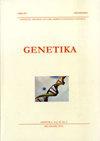基于分子标记的中国金蝶居群遗传多样性研究
4区 农林科学
Q3 Agricultural and Biological Sciences
引用次数: 0
摘要
本研究的目的是利用简单序列重复序列(ISSR)和线粒体(细胞色素氧化酶I - COI)分子标记,确定2016-2018年在伊朗不同地区(包括东阿塞拜疆、西阿塞拜疆、伊斯法罕、克尔曼、克尔曼沙阿、洛雷斯坦、马赞达兰、吉兰、Hormozgan和哈马丹省)采集的金鸡(Chrysoperla carnea)样本的遗传多样性。结果表明,10条ISSR标记引物共产生64条条带,其中43条为多态性条带。引物UBC-809和UBC-886的多态性率分别最高(88.88%)和最低(33.33%)。基于ISSR标记数据的聚类分析结果将样本分为三个独立的聚类。分子方差分析也证实了这一分组。分析结果显示,群体内和群体间的分子变异多样性分别约为84%和16%。本研究获得了5个单倍型。第一个单倍型(H1)在所有种群中都是常见的,可以认为是祖先的单倍型,其他单倍型都是从它进化而来的。本研究的新颖之处是首次利用ISSR和CO1标记对伊朗10多个省、30多个城市的蝶科植物进行遗传多样性分析,全面了解其遗传多样性。基于Jaccard指数的遗传距离矩阵表明群体的遗传距离较低。结果表明,ISSR和CO1标记在蝶科遗传多样性研究中具有较高的效率。本文章由计算机程序翻译,如有差异,请以英文原文为准。
Genetic diversity study of Chrysoperla carnea (Neuroptera: Chrysopidae) populations via molecular markers
The objective of this study was to determine the genetic diversity among Chrysoperla carnea samples collected from different locations of Iran (including, East-Azerbaijan, West-Azerbaijan, Isfahan, Kerman, Kermanshah, Lorestan, Mazandaran, Gilan, Hormozgan and Hamedan provinces) using the Inter simple sequence repeat (ISSR) and mitochondrial (Cytochrome Oxidase I - COI) molecular markers in 2016-2018. The results showed that a total of 64 bands were produced by ten primers of ISSR markers which among them 43 bands were polymorphic. The highest and lowest polymorphic percentages belonged to primer UBC-809 (88.88%) and primer UBC-886 (33.33%), respectively. The results of cluster analysis based on ISSR marker data divided the samples into three separate clusters. This grouping was also confirmed by analysis of molecular variance. According to the results of the analysis of molecular variance diversity within and among groups was about 84% and 16%, respectively. In the present study five haplotypes were obtained. The first haplotype (H1) was common in all populations which can be considered as the ancestral haplotype, the other haplotypes have been evolved from it. The novelty of this study is that we report the first time genetic diversity analysis of family Chrysopidae using ISSR and CO1 markers covering more than ten provinces and thirty cities of Iran with a full picture of its genetic diversity. Genetic distance matrix based on Jaccard index indicated low genetic distance of populations. The results showed that ISSR and CO1 markers have high efficiency in study of genetic diversity in the family Chrysopidae.
求助全文
通过发布文献求助,成功后即可免费获取论文全文。
去求助
来源期刊

Genetika-Belgrade
AGRONOMY-GENETICS & HEREDITY
CiteScore
1.80
自引率
0.00%
发文量
1
审稿时长
6-12 weeks
期刊介绍:
The GENETIKA is dedicated to genetic studies of all organisms including genetics of microorganisms, plant genetics, animal genetics, human genetics, molecular genetics, genomics, functional genomics, plant and animal breeding, population and evolutionary genetics, mutagenesis and genotoxicology and biotechnology.
 求助内容:
求助内容: 应助结果提醒方式:
应助结果提醒方式:


